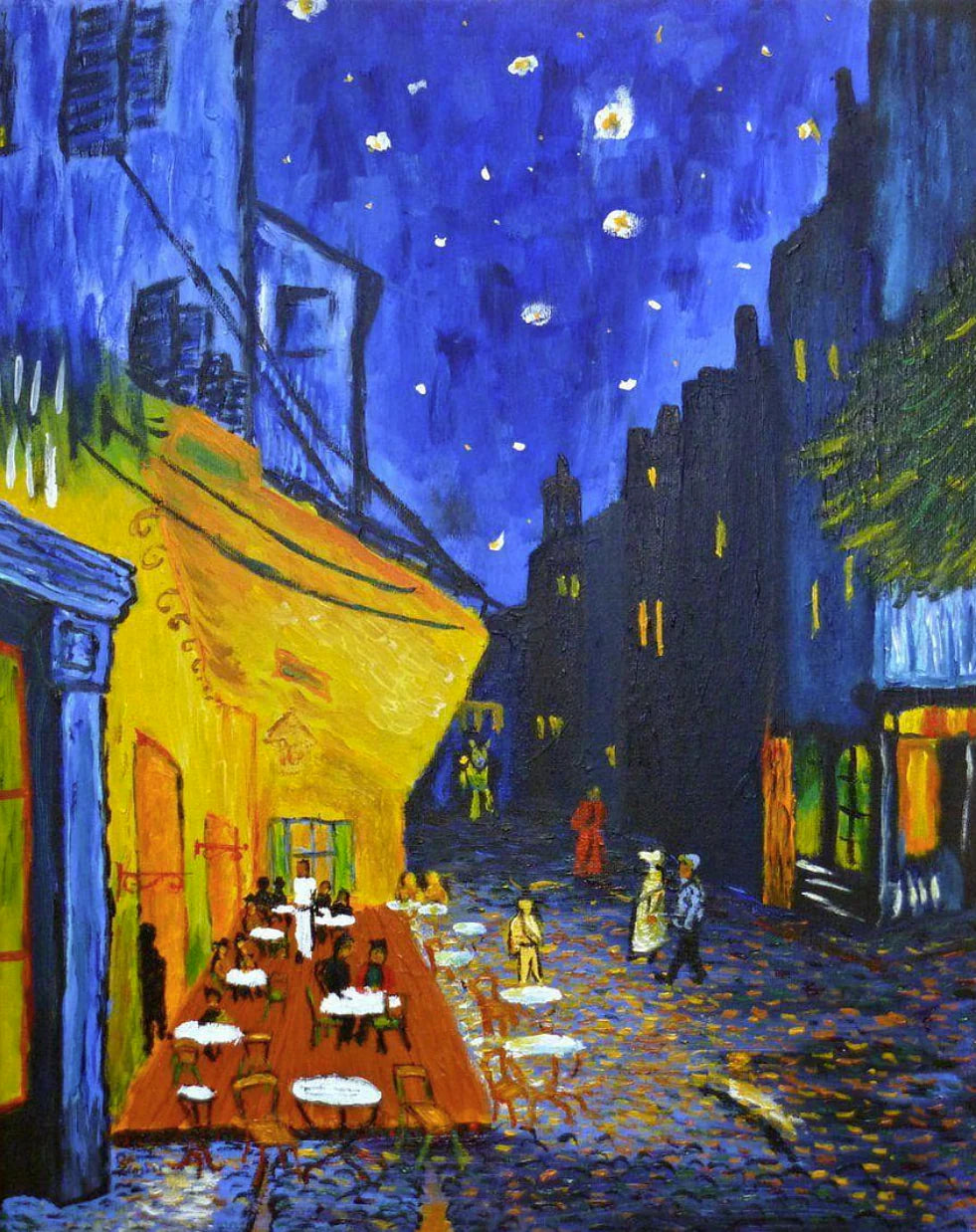
Why Van Gogh's Cafe Terrace at Night Captivates Art Lovers
Vincent van Gogh's "Café Terrace at Night" remains a masterpiece that continues to captivate art lovers around the globe. This spellbinding painting, with its vibrant colors and dynamic depiction of an intimate café scene, embodies the essence of life in a late 19th-century French town. Van Gogh's unique ability to imbue nocturnal tranquility with vivid luminosity not only marks a pivotal moment in art history but also offers a window into the artist's profound emotional and psychological landscape. It's not just the aesthetic appeal that draws enthusiasts; the intricate layers of meaning and technique behind the café terrace at night painting intrigue and inspire deep admiration.
Historical Context of Café Terrace at Night
Vincent van Gogh relocated to Arles, a picturesque village in the South of France, in early 1888, drawn by the quality of light reminiscent of Japan, a country whose art deeply influenced him. This period, known as the Arles period, is often considered the pinnacle of van Gogh's artistic career. During this time, he produced some of his most celebrated works, including "Café Terrace at Night." The artist's fascination with the night sky and vibrant colors is evident in this piece, where he captures the essence of the Place du Forum, the historical city center developed during Roman times.
Creation Date and Location
"Café Terrace at Night" was painted in mid-September 1888. Van Gogh set up his easel at the northeastern corner of the Place du Forum in Arles, capturing the lively café scene under the starlit sky. This painting, notable for its absence of black and use of vibrant blues and yellows, reflects the innovative techniques van Gogh developed during his time in Arles. Despite not being signed, the painting's authenticity is confirmed through detailed descriptions in three of van Gogh's letters, where he expresses his enthusiasm for night scenes that diverge from traditional depictions of the night.
Artistic Techniques and Style
Van Gogh's masterpiece is a testament to his innovative use of color and composition, influenced by both his contemporaries and the art from afar. This section delves into the artistic techniques and style that make this painting a masterpiece.
Use of Color
Van Gogh's palette in this artwork is striking, with bright yellows and oranges set against deep blues and greens. This powerful combination is not realistic, but it works brilliantly, showcasing van Gogh's ability to weave vivid colors together. The painting's nocturnal light effect, with the warm glow of gaslight intensifying the blues of the night sky, demonstrates van Gogh's fascination with color contrast. The gradation of color from the yellow light on the wall turning gradually to green, then to the rich blue of the sky, guides the viewer through the painting, highlighting van Gogh's skillful use of color to create luminosity and movement.
Compositional Elements
The composition is characterized by a strong sense of perspective, with the architecture providing a framework that leads the eye towards a vanishing point, hidden behind the buildings. This technique, coupled with the dark doorway on the left and the dark buildings on the right, focuses attention on the brightly lit café and the night sky. Despite the busy café being the focal point, it competes for attention with the star-filled sky, illustrating van Gogh's mastery in balancing different elements within a composition.
Influence of Japonism
The influence of Japanese art, particularly ukiyo-e woodblock prints, is evident in van Gogh's compositions, including "Café Terrace at Night." The painting features asymmetrical arrangements and a flattened, two-dimensional perspective, hallmarks of Japonism. This stylistic borrowing reflects van Gogh's admiration for Japanese art, which he shared with his fellow avant-garde artists in Paris. The cropping inspired by Japanese prints and the dramatic coloring are indicative of van Gogh's innovative approach to composition and his desire to infuse his work with the emotional intensity and simplicity found in Japanese art.
Symbolism and Interpretations
This painting is widely interpreted as containing deep religious symbolism, reminiscent of Leonardo da Vinci’s "The Last Supper." Scholars point out the central figure with long hair, flanked by twelve individuals, which mirrors the configuration of Jesus Christ and his twelve apostles. Additionally, the presence of a cross in the background and other cross-like shapes subtly integrated throughout the painting further suggest a religious undertone. This interpretation is supported by Van Gogh's own history and his letters, where he expresses a "tremendous need for religion," during the period he created this artwork. The shadowy figure leaving through the doorway is thought to represent Judas, adding another layer to the religious narrative embedded within the café scene.
Representations of Night
Van Gogh’s portrayal of the night sky not only showcases his innovative use of color but also serves as a symbolic element. He deliberately avoids using black to depict the night, instead employing vibrant blues and yellows, suggesting that night is not merely a time of darkness but is as rich and lively as the day. This choice reflects Van Gogh's fascination with the night, which he believed held a special kind of beauty and mystery. Astronomical accuracy in the positions of the stars adds another layer of depth, suggesting a universe aligned with moments of human interaction below. The interplay of natural and artificial light creates a dynamic scene that invites viewers to consider the coexistence of everyday life with the cosmic and eternal.
Legacy and Cultural Impact
The legacy of "Café Terrace at Night" is preserved and celebrated in several prestigious venues. The Kröller-Müller Museum in Otterlo, Netherlands, houses this iconic piece. Established by art collector Helene Kröller-Müller in 1938, the museum boasts the second-largest collection of Van Gogh's works, surpassed only by the Van Gogh Museum in Amsterdam. Visitors to the Kröller-Müller Museum can experience the magic of the "Café Terrace at Night" firsthand, where it continues to draw crowds, captivated by its vibrant colors and historical significance.
Depiction in Popular Culture
This painting has transcended the confines of traditional art spaces to make a significant impact in popular culture. It was featured prominently in the 1956 film "Lust for Life," which starred Kirk Douglas as Van Gogh, and more recently, it appeared in the critically acclaimed British TV series "Doctor Who" in the episode titled "Vincent and the Doctor" (2010). What’s more, the painting played a central role in the 2017 fully painted film "Loving Vincent," further cementing its place in the realm of popular media. The actual café depicted in the painting still exists under the new name Café Van Gogh, located at the northeastern corner of the Place du Forum in Arles, France. This site and its surroundings were reconstructed in 1990 and 1991 to mirror the ambiance captured by Van Gogh, offering visitors a tangible link to the past and the artist’s vision.
Final Thoughts
Vincent van Gogh's "Café Terrace at Night" stands as a beacon of artistic genius, illuminating the interconnectedness of color, light, and emotion in its vivid depiction of a peaceful evening. Through this work, van Gogh not only showcased his unparalleled ability to manipulate color and form but also embedded deep symbolic meanings that resonate with themes of community, spirituality, and the beauty of the nocturnal world. The painting's vibrant palette and innovative composition not only marked a significant moment in the history of art but also continue to mesmerize and inspire audiences with its compelling narrative and aesthetic allure.
What's more, the exploration of its historical context, technique, and lasting influence underscores the enduring relevance and fascination that "Café Terrace at Night" holds not only within the art community but also among the wider public.
Mini Masters Art provides art lovers with the unique opportunity to bring miniature renditions of masterpieces like "Café Terrace at Night" into their own spaces, enriching environments with the timeless beauty of art. This innovative approach allows for a deeper connection to the art world, making iconic works accessible and enjoyable in everyday settings.
The profound impact of "Café Terrace at Night" persists, not only as a testament to van Gogh's genius but also as a source of inspiration for creativity and artistic expression across diverse mediums and generations, encouraging us to see the beauty in our surroundings and within ourselves. Shop our Collection today!
I enjoyed reading your post. The way you approached was enlightening. It made me reflect on a discussion I recently had on illiciumlondon.co.uk/blog. I’d love to hear your thoughts. Keep up the good work!